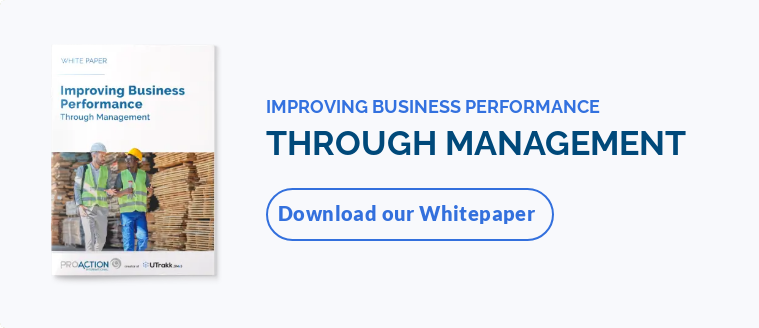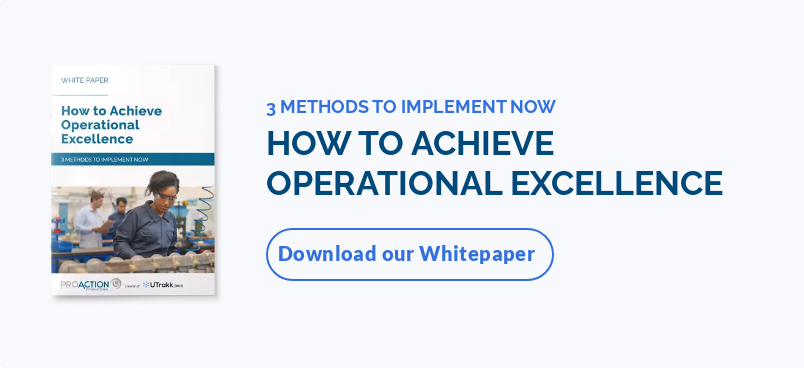What is change management in the manufacturing industry?
Change management refers to the ability of an organization to make organizational changes within its structure to better adapt to the constant evolution of this environment (internal and external). It allows the organization to continue to develop under all circumstances, and to be well-prepared for any eventuality, thus demonstrating adaptability, flexibility, and a solution-oriented approach. The COVID-19 pandemic is moreover a good example of a major change that most organizations had to face and adapt to continue operating.
In manufacturing, change management involves continuing to produce in the most cost-effective manner possible, while optimizing production processes and adopting a flexible attitude to change (labor shortages, raw material shortages, supply chain disruptions, technological innovations, etc.). To do this, manufacturers must put various organizational and anticipatory processes in place rather than improvising by only managing change once it occurs.
Why is it important?
Change management is a tremendous asset for manufacturers because it allows them to be prepared, deal with disruptions more calmly, and move forward by following these changes rather than wasting time, money, and energy trying to find solutions. In addition to productivity and profitability, it also affects employee motivation and commitment, the company's image, and customer satisfaction.

What are the 7 R's of change management?
The 7 R's are the key points to consider in the change management process. They are a series of 7 questions to ask:
-
RAISED - Who raised the change request?
-
REASON - What is the reason for the change?
-
RETURN - What return is required from the change?
-
RISKS - What are the risks involved in the change?
-
RESOURCES - What resources are required to deliver the change?
-
RESPONSIBILITY - Who is responsible for creating, testing, and implementing the change?
-
RELATIONSHIP - What is the relationship between this change and other changes?
The Unique Challenges of Change Management in Manufacturing
Leading an organization through a successful change isn't easy. Whether you're changing the organizational structure, technology, or workflow, you're likely to face challenges along the way. Let's look at how these changes can uniquely challenge the manufacturing industry.
1. Organizational Changes in Manufacturing
Organizational changes may include administrative procedures, hierarchy, job structure, management systems, and chain of command shifts. Such transitions aim to achieve business goals, respond to market opportunities or threats, and boost competitive advantage. The Chief Executive Officer (CEO) and upper management are often responsible for these strategic transformations.
One of the key challenges of implementing organizational changes is misunderstandings between the executives, especially regarding its purpose. Limited knowledge and resources for organizational change management may make success more difficult.
2. Technology Changes or Implementation in Manufacturing
In today's digital transformation, technology has become the linchpin on which many manufacturing companies grow and thrive. However, adopting new technologies (i.e., an ERP or an MES) does have its challenges. The initial development may be pricey and overwhelming to some organizations. Besides, your staff must be trained on how to use the new technology, which increases the costs.
Implementing new technology may be disruptive in the short run, and some businesses do not have the financial muscle to support the temporary losses caused by the disruption.
3. Workflow Changes in Manufacturing
Workflow changes include shifts in processes and operations on the shop floor involved in producing goods using machines, raw materials, and labor. These encompass the entire manufacturing process changes, from materials requirement planning and supply chain to assembly, testing, and delivering the final product. Changing these processes aims to produce high-quality products cost-effectively and efficiently.
One of the challenges of implementing workflow changes is the disruption in business operations, which may lead to significant short-term losses. Resistance of employees to change is also a major challenge that requires effective communication from the senior management to help them foresee the prevailing benefits.
What Are the Best Manufacturing Change Management Strategies?
A holistic approach to change management has proven effective for many companies. Here are the best change management strategies to guide manufacturers through their next transitions.
First strategy: 5-step change management process for manufacturing companies
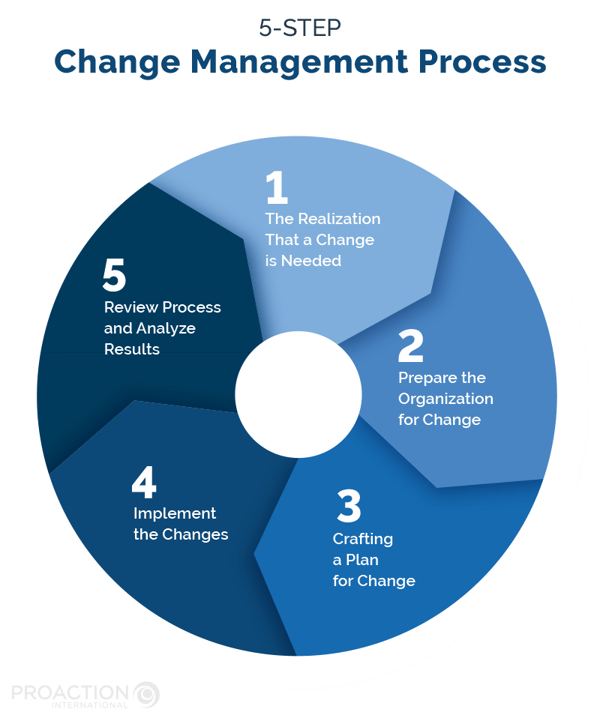
1. The Realization That a Change is Needed
Change management begins by realizing that something must be done differently. Some factors that could trigger change include significant changes in the market, poor company performance, customer demand, competitor behavior, new technologies, internal restructuring, a need for automation, and more.
2. Prepare the Organization for Change
Once you identify the areas of change, it's best to prepare employees logically and culturally. As a manager, you should focus on raising awareness of the various challenges the organization is facing and how implementing changes will help. Gaining this initial buy-in from employees is a perfect way to remove resistance and friction later. Here, using Nonviolent communication is essential in exchanges.
The ideal for team cohesion is to prepare the plan with them. When possible, involving employees is always a way to ensure the success of any project implementation. Either by building it or challenging it.
Magali Mansion - Senior Consultant, Proaction International
3. Crafting a Plan for Change
A practical and realistic plan makes implementation far more likely to succeed. Your change management plan should highlight strategic goals, initiative team, stakeholders, scope, key performance indicators, and metrics. It must also account for possible roadblocks that require flexibility and agility.
4. Implement the Changes
So now, you have a solid plan. What remains is following the outlined steps to implement the new system. Whether that involves transforming employee behavior or changing the company's structure, systems, or processes will depend on the initiative specifics.
During this process, you should empower employees to take necessary steps toward achieving the initiative's goals and celebrate any short-term wins. Repeated communication of the company's vision is imperative to keep reminding the team why change is being pursued.
5. Review Process and Analyze Results
The final part of change management should be to review and analyze the results of the new approach. Doing this will help you determine whether the change initiative was a success or failure. It also provides valuable lessons and insights to leverage in future change efforts.
Second strategy: Kotter's 8-Step Change Model Applied to Manufacturing
Kotter's 8-step change management model is relatively easy to implement as it gives a precise description and guidance on the whole change process. It emphasizes employee engagement and acceptability for the success of the process.
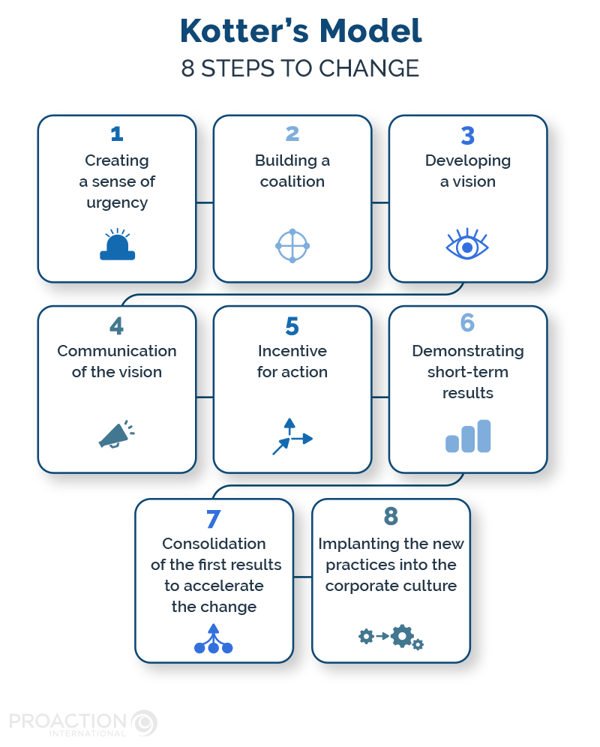
Step 1 - Create a Sense of Urgency
According to John Kotter, the change process should establish a sense of urgency among the people participating in it. This includes senior management, employees, and key stakeholders. Identify the potential repercussions and threats that might crop up if the change is not implemented to make them see the need for urgency. This step requires an honest, open, and convincing dialogue.
Step 2 - Form a Guiding Coalition
You must bring together a proficient team with the requisite skills, qualifications, connections, and reputation to provide sufficient governance to the change efforts. The team size will vary based on the nature of the proposed change initiative.
Each member should clearly understand their roles, responsibilities, and performance measures. Always focus on developing an environment of commitment and trust to achieve success.
Step 3 - Develop Vision and Strategies
This step aims to create a realistic vision to drive the new initiative and develop robust strategies that will guide the team toward achieving the vision. It provides a clear picture of how the company will look after a change is implemented. A good vision should define clear and realistic targets for easy success measuring.
Step 4 - Communicate the Vision
Effective communication of the vision and strategies captures the hearts and minds of the team, making them sacrifice time and effort to support the change. Encouraging feedback from them and addressing their concerns, anxieties, and problems openly and honestly is always good. Utilize different communication channels to get the word out and increase engagement.
Step 5 - Remove Barriers to Action
Obstacles are bound to occur during the change implementation process. They may be in the form of employee resistance, insufficient processes, disempowering leaders, etc. This step aims to eliminate all obstacles that block a company's path to achieving its vision.
As a manager, you must clearly understand these barriers and ensure that the organizational policies, structures, and processes align with the new change vision.
Step 6 - Creating Short-Term Wins
Celebrating short-term wins early in the change process is a perfect way to feel victory and keep employees motivated. Break the change initiative into smaller sections with short-term goals and reward those responsible for quick wins.
Step 7 - Build on the Change
You'll want to ensure that the teams persistently work towards achieving the initiative's vision while measuring progress. A few quick wins could make them declare victory prematurely and abandon their responsibilities. Continue reminding them of the organizational vision and identify areas of improvement to enhance efficiency.
Step 8 - Make Change Part of the Culture
Kotter emphasizes making change is an integral part of your organizational culture and ensuring it's visible in every aspect. As a manager, you are responsible for continuous improvement, fostering a suitable environment for smooth change processes, and preparing your team for future changes. Ensure that the support of leaders toward change continues to extend.
Third strategy: Prosci's methodology for change management
Founded in 1994 by Jeff Hiatt, a former engineer and program manager at Bell Labs, Prosci is a world-renowned American firm specializing in change management. In particular, it has developed a methodology called ADKAR to propose best practices for successful change management.
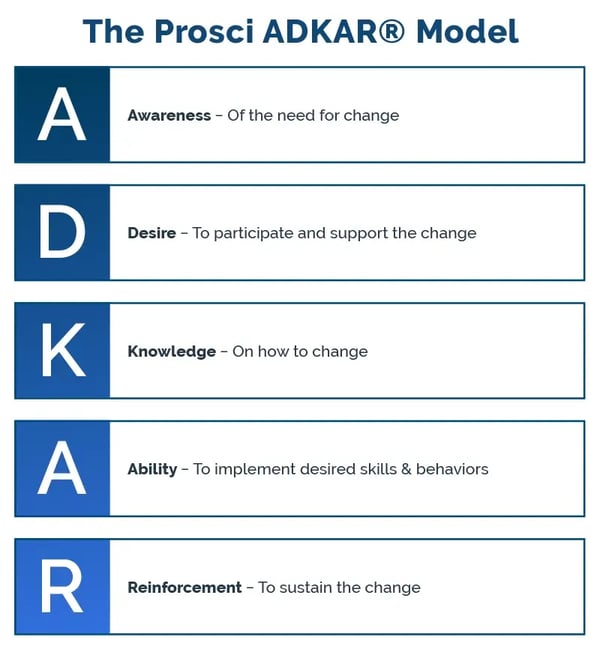
The ADKAR method is broken down into 5 steps:
-
Awareness - Becoming aware of the need for change
Why does change happen?
Why is it necessary?
What kind of change is it?
-
Desire - Desire to accompany change
What motivates people to participate in change?
How can the organization motivate and support people in change?
-
Knowledge - Knowledge of how to change
What means should be used to effect change?
How can change be achieved?
-
Ability - Ability to demonstrate appropriate change skills and behaviors
How to implement the change in daily life?
What are the possible obstacles to the implementation of change?
-
Reinforcement - Reinforcement to sustain the change
How to make the change be sustainable?
What processes and tools should be used to make the change sustainable?
How to encourage and reward change?
Resistance to change: a major factor
According to Prosci, managing change requires good management of resistance to that same change. To do this, five pieces of advice stand out as priorities:
Manage change well from the start
Implement effective change management from the start of a project or initiative to use it as a driver for activating and engaging employees in a change.
Expect resistance to change
It is natural to encounter resistance to change, and it is important to analyze and address the sources of resistance before starting the project.
Addressing resistance formally
A precise process must be set up to give a concrete framework for the change. Here, Prosci relies on three phases: preparatory approach (identifying resistance points and strategies for dealing with them), change management (supporting individuals in their ADKAR transitions), and sustainability (reviewing the performance of resistance management activities and documenting lessons learned for the future).
Identify the root causes of resistance
Rather than staying on the surface, understand the real reasons why each individual resists change, for example, by talking to the resistant employee and his or her human resources manager. Engage the "right" resistance managers. The change management team is not effective in managing resistance. The "right" managers of resistance in an organization are the leaders as well as the human resources managers.
Source: Prosci
Strategies of Proaction International coaches
For this article, we asked some of our coaches about how they approach change management in their practice since everything we do at Proaction International requires change management. Here are some of their tactics:
Matthew Pirie - Senior Consultant, Proaction International
To effectively overcome resistance to change, people need to understand several things:
-
Why is the change being implemented, and why are we doing it this way?
-
What's in it for me? What are the benefits of the change? What will be the negative consequences for me? Do the negatives outweigh the positives?
Also, the people who will be affected by the change need to have their opinions heard. Since they are doing the process every day, they are in the best position to understand the potential unintended consequences of the change and how to mitigate those consequences. In addition, they may have a better idea of what or how to change to achieve better results. Ultimately, the people doing the work need to have a say in how it is done.
Rebecca McCann - Project Manager, Proaction International
The first step in coaching when a manager seems resistant is to find out why he or she tends to resist. Is it because they are afraid? Is it that he takes the change as criticism or personal blame? Is it because they don't see the added value of making a change in their daily lives?
By asking the right open-ended questions and by actively listening, we can adapt our coaching according to where the manager is on the emotional curve.
In general, here are the points I address with a manager to deal with resistance to change:
-
Make progress points, and highlight the good stuff;
-
Dare to talk openly about the blocking points, name them, and respect the manager in his state of being;
-
Set time objectives to achieve the change;
-
Categorize the change according to its scope, importance, and level of risk;
-
Propose a series of actions related to the previously defined category of change;
-
Associate tools with these actions;
-
Identify learning opportunities for the organization.
Maxime Gaudreau - Coach, Proaction International
Every situation is different, as much by the reason and nature of the changes as by their scope and complexity. Generally speaking, when a manager does not know where to start, I like to go back to the basics. Treating a change situation as a project is always a good idea:
-
An analysis leading to a clear definition of the project and its scope (what it includes, and especially what it does not include);
-
Identify stakeholders and assemble a project team;
-
Develop a detailed plan;
-
Establish a communication plan;
-
Identify risks and mitigation strategies.
As long as it has an impact on the organization, I believe there is always a benefit to going through each step of the project management process. This can be done quickly for small projects, but it maximizes our chances of covering aspects that are sometimes easy to forget. My experience shows that no matter which way you go, you always end up going through all these steps in a project that achieves its goals.
In terms of getting people on board and guiding them through change, I like to use Jeff Hiatt's ADKAR model when coaching managers.
Mario Sergio Garcia - Senior Consultant, Proaction International
Here are some of my tips to facilitate the management of change by a manager within his team/organization:
- Create and maintain a sense of urgency
It is important for the manager to establish and maintain a clear vision of change. This is possible by linking it directly to a solution to a strategic business issue or opportunity. It is even more important to convey a sense of urgency through a channel that is conducive to the change in a clear language that reaches the key actors of the change.
- The key players in the change
The manager must ensure that a critical mass of people will support the change. To do this, he or she must often rely on leaders who share a sense of urgency and have a role of influence in their environment. Generally, these are credible and mobilizing members of the team. This facilitates the propagation of the sense of urgency and creates the group effect that is so necessary when "good reasons" are not enough to replace the sense of security generated by the status quo.
- Listen actively
The manager must listen to the main concerns of those affected by the change. They must be careful to recognize the phases of the emotional curve during the transition. This means that communication must continue throughout the change to reduce stress caused by uncertainty or rumors. Victories, no matter how small, must be celebrated!
- Coaching
Coaching is one of the best ways to anchor the change in the culture and thus ensure its sustainability. It helps to avoid giving in to the status quo by relying on the support of a leader (or change agent). Positive reinforcement through coaching helps the employee to take ownership of the change and to perpetuate the new expected behaviors.
Leo Normandin - Senior Consultant, Proaction International
You have to start with yourself; make sure that everything is clear to the person who has to accompany the change:
-
Why - Why do we want to make a change (financial, organizational, operational gains, etc.)?
-
Who - Who is involved in the change? Who is the manager? What is their position? What are his stakes, his motivations ions, and his personality?
-
How - How will we accompany the change? How will we make it happen? As a team or alone? Is it a human or a digital change?
-
What - What exactly is the change we are talking about (a line, the schedule, the work organization, etc.)?
-
When - What is the timeframe? When does the change have to take place, and for how long?
How To Deal With Resistance to Change
Human nature often pushes employees to resist change because adjusting requires relinquishing some control, moving out of their comfort zones, and facing the unknown. The following tips can help you handle resistance in your manufacturing company:
-
Expect resistance and acknowledge it;
-
Effectively communicate the need for change and its benefits;
-
Elaborate on the change in terms of how much effort is needed from each employee;
-
Describe the results and how they will pay off to motivate employees to work more effectively;
-
Allow employee feedback and address their concerns;
Change Management Without Good Managerial Leadership Is Set to Fail
Organizational change does not succeed without good leadership. Managers unwilling to devote the time, effort, and resources needed to support change often fail to achieve the desired results. Leaders must actively and consistently support their teams as they design and implement changes to avoid this.
Conclusion
Leading a change management strategy takes a lot of effort and dedication. Besides, even the most successful managers will likely make a few mistakes along the way, especially if it's their first time implementing and leading change. Luckily, with professional support from Proaction International's change management experts, you can develop a strategy that will help you realize your vision.





